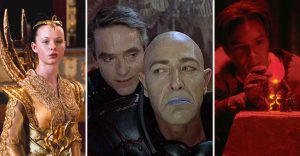Hamilton: Why The Same Actor Plays Peggy Schuyler & Maria Reynolds

In the musical phenomenon Hamilton, oft applauded for its crafty attention to detail, actress Jasmine Cephas Jones plays both Peggy Schuyler and Maria Reynolds, creating an important link between the two characters. In theatre, the term “doubling” refers to a stage convention where one actor plays more than one role for a single performance. Hamilton has several actors play multiple parts, which helps pull out resonant themes and draw connections between the doubled characters.
Addressing his specific reasoning for doubling roles in Hamilton on Twitter, Lin-Manuel Miranda wrote, “I realized early that characters that were important early in his life fade away while others appear later. The double casting was so that we’d be INSTANTLY invested.” John Laurens and Philip Hamilton (both Anthony Ramos) are linked by their intimate connection with Hamilton, as well as their untimely, tragic, and ultimately influential deaths. Marquis de Lafayette/Thomas Jefferson and Hercules Mulligan/James Madison (played by Daveed Diggs and Okieriete Onaodowan, respectively) are defined by fighting with Hamilton (the “we fought with him” line in the show’s opening number is clever – they fight alongside him in Act I and against him in Act II). But what of the roles doubled by Jones, Peggy and Maria? Both characters have only a few moments to shine before essentially disappearing into the show’s Greek chorus. Likewise, both historical figures largely remain shrouded in mystery all these years later – much of what has been written about them has been informed by varying accounts and American legend. Perhaps that is the point.
While she and her family were very much a part of the revolution, the real Peggy Schuyler’s only substantial story involves an incident involving outrunning a tomahawk when a group Torres and Native Americans invaded their home in Albany with the hopes of capturing her father – the incident and Peggy’s involvement has been largely dismissed as a piece of American Urban Legend. There is a bit more to learn about Maria Reynolds, but even that information is full of gaps. Documentation shows that she was married multiple times, but details are scarce. As far as her affair with Hamilton is concerned, her historic perspective and motives have been something of a mystery. Some historians assert she had deep romantic feelings for Hamilton (notably she is added to the “Me? I loved him” line in the musical’s opening number, in unison with Eliza and Angelica), but others have suggested that she was in on the scheme.

The silence of real-life Peggy and Maria mirrors the narrative treatment of both characters within the confines of the musical. Peggy’s iconic (and very meme-able) line “…and Peggy!” comes off as laughable and, musically, written to be an anti-climactic afterthought; not unlike Peggy Schuyler, herself, at least as far as history books go. She herself is an afterthought; a footnote. Beyond her inclusion in the song “The Schuyler Sisters,” Peggy is given no additional solo lines and soon, unceremoniously fades into the Greek Chorus – her own perspective is never truly explored like that of the other named characters in Act I.
Later in Act 2, when witnessing Jones’ subtle expressions as she portrays an ashamed, yet silent Maria Reynolds in “The Reynolds Pamphlet,” it is hard to not feel a sense of sadness for her. The pamphlet, published by Hamilton, was written in order to clear his own name and protect his own legacy, regardless of the damage done to his mistress. The idea of being an afterthought, once laughable with Peggy in Act I, is suddenly not so funny and the audience finds itself complicit in the act of robbing Maria (embodied by Jones) the right to tell her story in her own words, just as American culture has for the last two hundred years.
Hamilton exists at the intersection of American history and current obsessions with legacy. With their stories and parallel falls out of the narrative, the Peggy Schuylers and Maria Reynolds of the world are not uncommon. By casting the same actor to play both roles, Hamilton’s creators certainly establish an instant investment for an audience and, in so doing, highlight viewers’ own fears of being misrepresented and forgotten when they are gone. Smart and purposeful, this is a clever utilization of theatrical doubling. But for what has been widely lauded as the musical of a generation, did anyone expect any less?
Hamilton: All 46 Songs In The Musical, Ranked From Worst To Best
About The Author

















